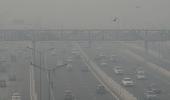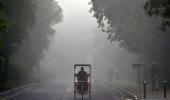Delhi's air quality plummeted to the "severe plus" category Friday even as the central government deferred the implementation of stricter measures under the air pollution control plan, saying the AQI in the region is already showing a declining trend.

On Friday, Delhi's 24-hour average air quality index (AQI) reached 468, placing it in the "severe plus" category. This is the stage at which all emergency measures, including a ban on polluting trucks, commercial four-wheelers, and all types of construction, are mandated in Delhi-NCR.
The city's AQI on Friday was the worst since the previous high recorded on November 12, 2021.
However, during a review meeting, the Commission for Air Quality Management (CAQM) decided to monitor the situation for a day or more before implementing stricter curbs.
It said curbs under Stage III of the Graded Response Action Plan were implemented only a day ago; and it's reasonable to allow time to have their full impact on AQI in the region, according to an update shared in the evening.
The hazardous pollution levels compelled many to forgo their morning walks, sports and other outdoor activities.
Sanjay Kabir, a resident of Dwarka, said he has been avoiding morning and evening walks, choosing to stay indoors instead.
The count of masked faces continued to rise as the city remained enveloped in a pungent haze for the fourth consecutive day. It seemed as if the capital had returned to the early days of the Covid-19 pandemic.
Parents are a worried lot as health experts say children breathe faster, taking in more pollutants.
Under the final stage (Stage IV) of GRAP, only CNG, electric, and BS VI-compliant vehicles from other states are allowed to enter Delhi, with exemptions granted to those involved in essential services. It also includes work-from-home directives for 50 per cent of staff in government and private offices.
On Thursday, the pollution control body ordered a ban on non-essential construction work and specific categories of polluting vehicles.
GRAP categorises actions into four stages: Stage I - 'poor' (AQI 201-300); Stage II - 'very poor' (AQI 301-400); Stage III - 'severe' (AQI 401-450); and Stage IV - 'severe plus' (AQI above 450).
The Delhi government has also announced the closure of all primary schools for two days in an effort to safeguard young children from the health-threatening pollution.
The city's AQI skyrocketed from 351 at 10 am on Thursday to 471 at 9 am on Friday, reflecting a sudden increase in pollution levels due to highly unfavourable meteorological conditions and a sharp spike in stubble burning incidents in neighbouring states.
Delhi's 24-hour average AQI, recorded at 4 pm each day, was 392 on Thursday, 364 on Wednesday, 359 on Tuesday, 347 on Monday, 325 on Sunday, 304 on Saturday, and 261 on Friday.
These numbers indicate a gradual deterioration in Delhi's air quality over the past few days, culminating in a descent into the severe category on Thursday.
The concentration of PM2.5, fine particulate matter capable of penetrating deep into the respiratory system and triggering health problems, exceeded the safe limit of 60 micrograms per cubic metre by seven to eight times at multiple locations throughout the region.
The air crisis is not confined to Delhi alone; several cities in neighbouring Haryana, Rajasthan and Uttar Pradesh have also reported hazardous air quality.
These cities include Hanumangarh (401), Bhiwadi (379), and Sri Ganganagar (390) in Rajasthan; Hisar (454), Fatehabad (410), Jind (456), Rohtak (427), Ballabgarh (390), Bahadurgarh (377), Sonepat (458), Kurukshetra (333), Karnal (345), Kaithal (369), Bhiwani (365), Faridabad (448), and Gurugram (366) in Haryana; and Ghaziabad (414), Baghpat (425), Meerut (375), Noida (436), and Greater Noida (478) in Uttar Pradesh.
After a meeting to review the air pollution situation, Delhi Environment Minister Gopal Rai called upon his Union counterpart Bhupender Yadav to become "active" in addressing the air pollution problem, emphasising that it's not just the national capital but the entire North India that is breathing polluted air.
Rai said the BJP is blaming Chief Minister Arvind Kejriwal for the air pollution problem in Delhi, but he is not responsible for the poor air quality in Uttar Pradesh and Haryana.
The minister also said the large smog tower installed at Connaught Place two years ago to reduce air pollution in the vicinity has been shut down arbitrarily on the orders of Delhi Pollution Control Committee Chairman (DPCC) Ashwani Kumar.
He said Kumar, who assumed the role of DPCC chairman in December, "stopped the release of funds to IIT-Bombay and other agencies working on the project, without informing the government".
Kejriwal had inaugurated the more-than-24-metre-high smog tower at Connaught Place on August 23, 2021. The city government had formed a team of experts from Indian Institute of Technology (IIT), Bombay to study its impact over two years.
A scientist at the India Meteorological Department told PTI: "We expect the unfavourable weather conditions - low wind speed, non-conducive wind direction and lack of rain - to persist for another two to three days, allowing for further accumulation of pollutants."
The IMD said visibility levels dropped to just 500 m at the Safdarjung and the Palam observatories during the day.
Health professionals have expressed concerns that air pollution is increasing asthma and lung problems in children and the elderly.
"We are recording a surge in the number of irritative bronchitis infections. It is recommended that people suffering from respiratory issues such as chronic bronchitis and asthma take their medicines regularly and do not go out in the open unless absolutely necessary," said Jugal Kishore, head of the medicine department at Safdarjung Hospital.
Considering the spike in indoor pollution in Delhi, he advised people to use air purifiers in their homes.
Unfavourable meteorological conditions, combined with emissions from firecrackers, paddy straw burning, and local pollution sources, contribute to hazardous air quality levels in Delhi-NCR during winter.
According to an analysis conducted by the Delhi Pollution Control Committee (DPCC), the capital experiences peak pollution from November 1 to November 15 when the number of stubble burning incidents in Punjab and Haryana increase.
Air pollution in India resulted in 1.67 million deaths in 2019 -- the largest pollution-related death toll in any country in the world -- and accounted for USD 36.8 billion in economic losses, according to a new study by researchers from the Global Observatory on Pollution and Health at Boston College, the Indian Council of Medical Research, and the Public Health Foundation of India.
One of the major reasons behind the accumulation of pollutants in recent days is the lack of rainfall during this post-monsoon season so far.
In contrast to October 2022 (129 mm) and October 2021 (123 mm), Delhi experienced only one rainy day (5.4 mm of precipitation) in October 2023. There has been no rain in November so far.
According to a numerical model-based system developed by the Indian Institute of Tropical Meteorology in Pune, smoke from stubble burning accounted for 35 per cent of the PM2.5 pollution in Delhi on Friday, rising from 25 percent on Thursday.
The Delhi-based Indian Agricultural Research Institute said Punjab and Haryana reported 1,551 and 28 incidents of stubble burning on Friday.
A scientist from the institute said that Punjab and Haryana experienced an increase in paddy production this year due to the lack of cloud cover, resulting in an abundance of paddy straw.











 © 2025
© 2025